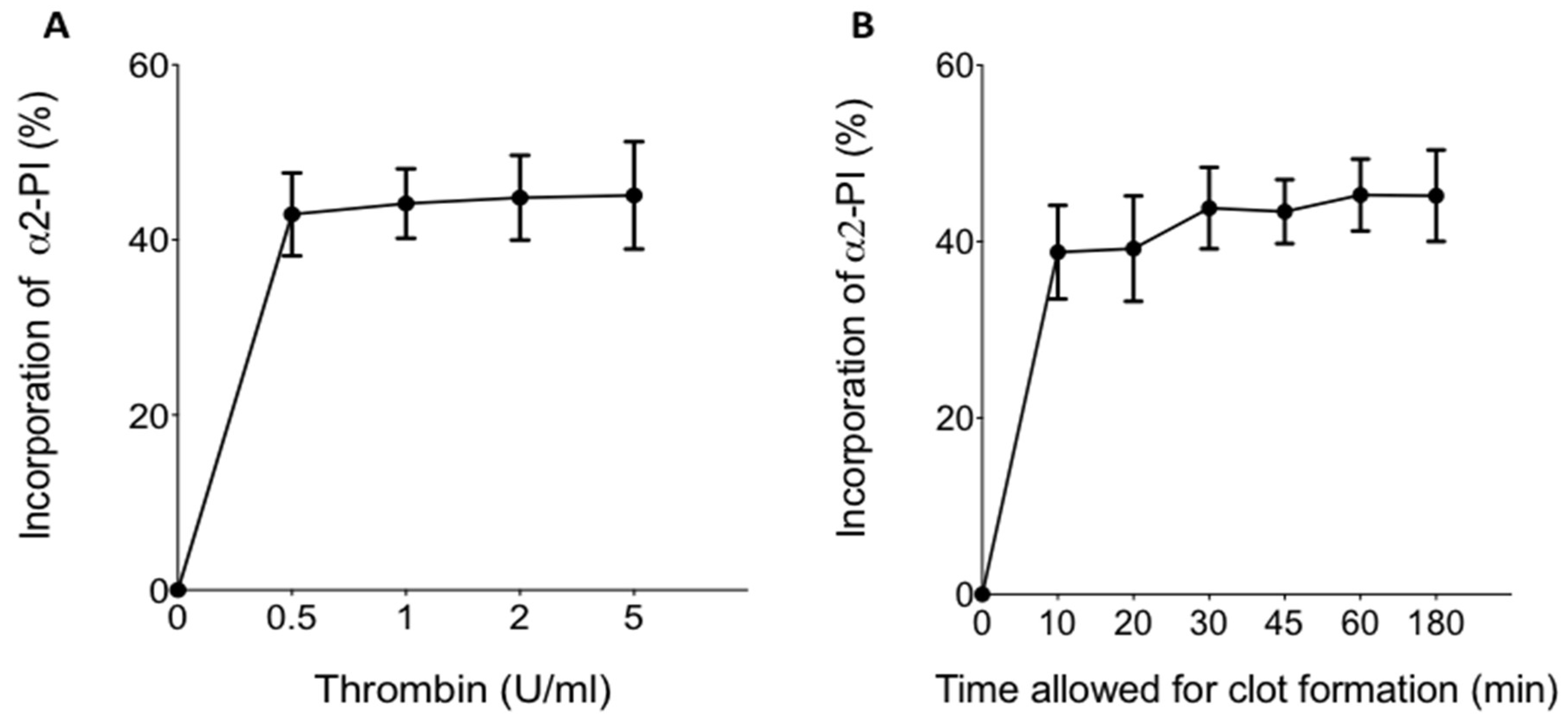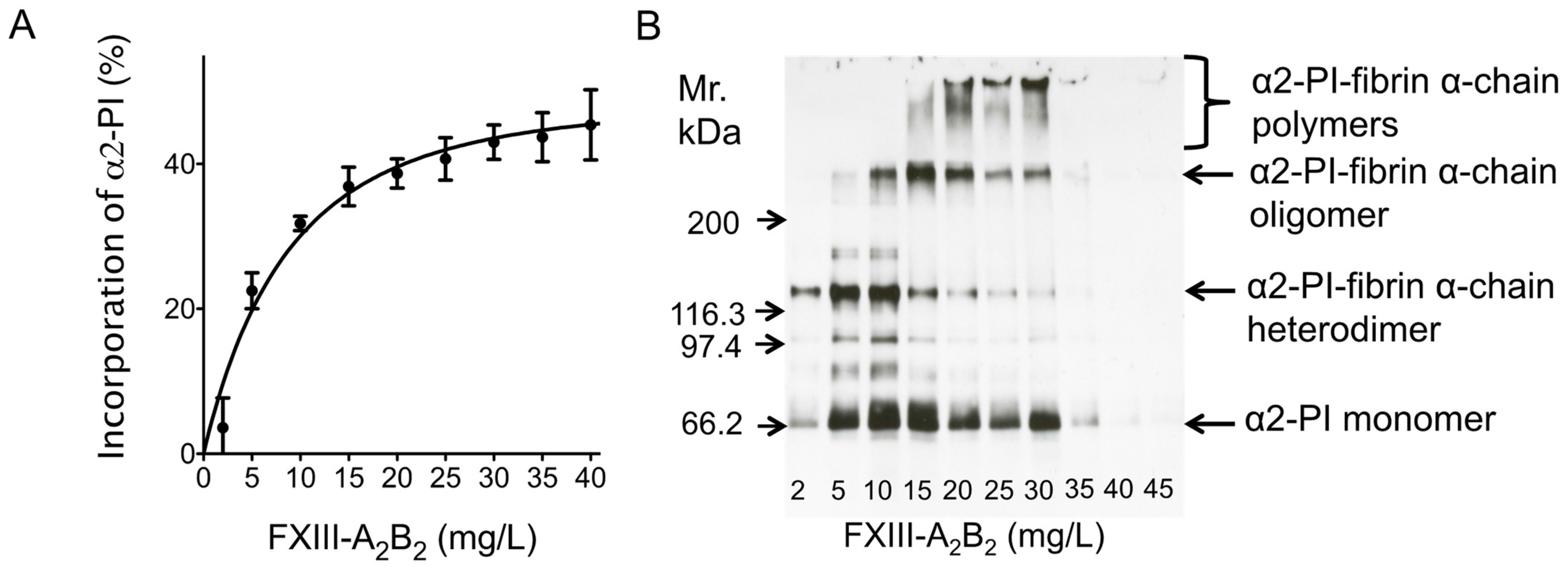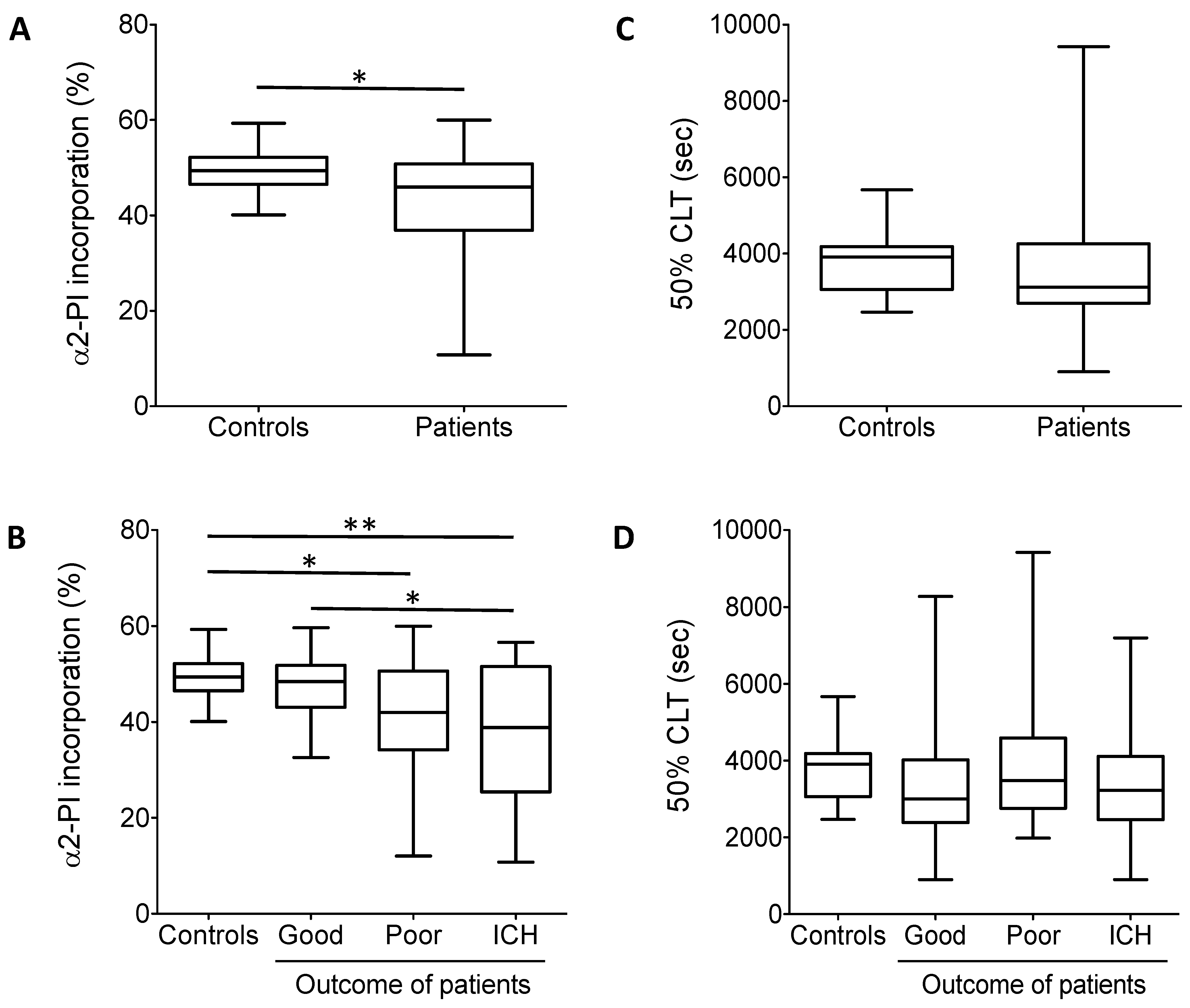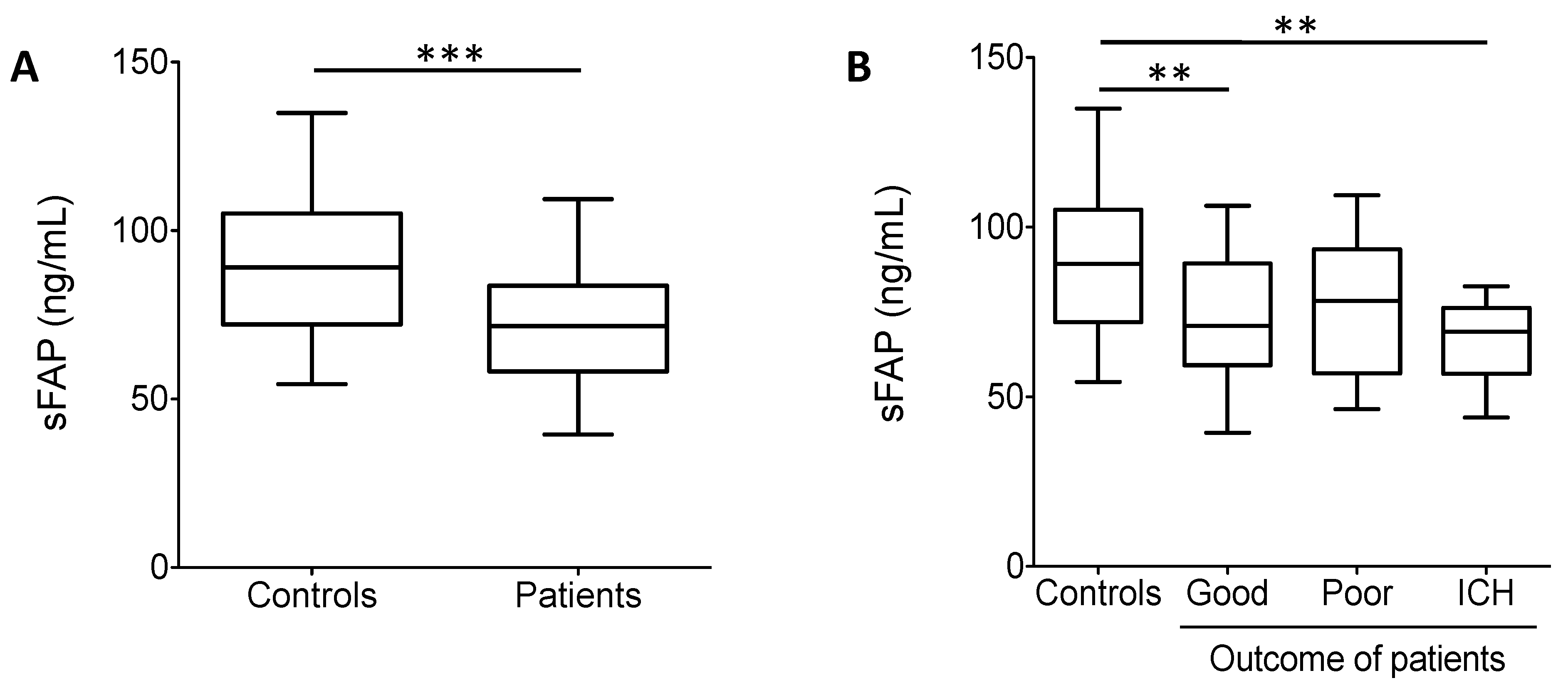Incorporation of α2-Plasmin Inhibitor into Fibrin Clots and Its Association with the Clinical Outcome of Acute Ischemic Stroke Patients
Abstract
1. Introduction
2. Materials and Methods
2.1. α2-Plasmin Inhibitor Incorporation Assay
2.2. Patients and Controls
2.3. Blood Sampling and Laboratory Measurements
2.4. Statistical Analysis
3. Results
3.1. The Effect of Thrombin Concentration and Time on the Incorporation of α2-PI into Fibrin Clots
3.2. The Effect of FXIII Concentration on the Incorporation of α2-PI into Fibrin Clots
3.3. The Extent of α2-PI Incorporation into Plasma Clots in Acute Ischemic Stroke Patients and Its Relation to Thrombolysis Outcome
4. Discussion
5. Conclusions
Author Contributions
Funding
Institutional Review Board Statement
Informed Consent Statement
Data Availability Statement
Acknowledgments
Conflicts of Interest
References
- Chapin, J.C.; Hajjar, K.A. Fibrinolysis and the control of blood coagulation. Blood Rev. 2015, 29, 17–24. [Google Scholar] [CrossRef] [PubMed]
- Mendez, A.A.; Samaniego, E.A.; Sheth, S.A.; Dandapat, S.; Hasan, D.M.; Limaye, K.S.; Hindman, B.J.; Derdeyn, C.P.; Ortega-Gutierrez, S. Update in the Early Management and Reperfusion Strategies of Patients with Acute Ischemic Stroke. Crit. Care Res. Pract. 2018, 2018, 9168731. [Google Scholar] [CrossRef] [PubMed]
- NNational Institute of Neurological Disorders; Stroke rt-PA Stroke Study Group. Tissue plasminogen activator for acute ischemic stroke. N. Engl. J. Med. 1995, 333, 1581–1587. [Google Scholar] [CrossRef] [PubMed]
- Wardlaw, J.M.; Murray, V.; Berge, E.; del Zoppo, G.; Sandercock, P.; Lindley, R.L.; Cohen, G. Recombinant tissue plasminogen activator for acute ischaemic stroke: An updated systematic review and meta-analysis. Lancet 2012, 379, 2364–2372. [Google Scholar] [CrossRef]
- Wardlaw, J.M.; Murray, V.; Berge, E.; del Zoppo, G.J. Thrombolysis for acute ischaemic stroke. Cochrane Database Syst. Rev. 2014. [Google Scholar] [CrossRef] [PubMed]
- Miller, D.J.; Simpson, J.R.; Silver, B. Safety of thrombolysis in acute ischemic stroke: A review of complications, risk factors, and newer technologies. Neurohospitalist 2011, 1, 138–147. [Google Scholar] [CrossRef] [PubMed]
- Donkel, S.J.; Benaddi, B.; Dippel, D.W.J.; Ten Cate, H.; de Maat, M.P.M. Prognostic Hemostasis Biomarkers in Acute Ischemic Stroke. Arterioscler. Thromb. Vasc. Biol. 2019, 39, 360–372. [Google Scholar] [CrossRef] [PubMed]
- Bagoly, Z.; Szegedi, I.; Kalmandi, R.; Toth, N.K.; Csiba, L. Markers of Coagulation and Fibrinolysis Predicting the Outcome of Acute Ischemic Stroke Thrombolysis Treatment: A Review of the Literature. Front. Neurol. 2019, 10, 513. [Google Scholar] [CrossRef] [PubMed]
- Szegedi, I.; Nagy, A.; Szekely, E.G.; Czuriga-Kovacs, K.R.; Sarkady, F.; Lanczi, L.I.; Berenyi, E.; Csiba, L.; Bagoly, Z. PAI-1 5G/5G genotype is an independent risk of intracranial hemorrhage in post-lysis stroke patients. Ann. Clin. Transl. Neurol. 2019, 6, 2240–2250. [Google Scholar] [CrossRef] [PubMed]
- Szekely, E.G.; Czuriga-Kovacs, K.R.; Bereczky, Z.; Katona, E.; Mezei, Z.A.; Nagy, A.; Toth, N.K.; Berenyi, E.; Muszbek, L.; Csiba, L.; et al. Low factor XIII levels after intravenous thrombolysis predict short-term mortality in ischemic stroke patients. Sci. Rep. 2018, 8, 7662. [Google Scholar] [CrossRef]
- Bagoly, Z.; Ariens, R.A.S.; Rijken, D.C.; Pieters, M.; Wolberg, A.S. Clot Structure and Fibrinolysis in Thrombosis and Hemostasis. Biomed. Res. Int. 2017, 2017, 4645137. [Google Scholar] [CrossRef] [PubMed]
- Wiman, B.; Collen, D. On the mechanism of the reaction between human alpha 2-antiplasmin and plasmin. J. Biol. Chem. 1979, 254, 9291–9297. [Google Scholar] [CrossRef]
- Abdul, S.; Leebeek, F.W.; Rijken, D.C.; Uitte de Willige, S. Natural heterogeneity of alpha2-antiplasmin: Functional and clinical consequences. Blood 2016, 127, 538–545. [Google Scholar] [CrossRef] [PubMed]
- Muszbek, L.; Bereczky, Z.; Bagoly, Z.; Komaromi, I.; Katona, E. Factor XIII: A coagulation factor with multiple plasmatic and cellular functions. Physiol. Rev. 2011, 91, 931–972. [Google Scholar] [CrossRef] [PubMed]
- Muszbek, L.; Bagoly, Z.; Bereczky, Z.; Katona, E. The involvement of blood coagulation factor XIII in fibrinolysis and thrombosis. Cardiovasc. Hematol. Agents Med. Chem. 2008, 6, 190–205. [Google Scholar] [CrossRef]
- Sakata, Y.; Aoki, N. Cross-linking of alpha 2-plasmin inhibitor to fibrin by fibrin-stabilizing factor. J. Clin. Investig. 1980, 65, 290–297. [Google Scholar] [CrossRef] [PubMed]
- Lee, K.N.; Jackson, K.W.; Christiansen, V.J.; Chung, K.H.; McKee, P.A. A novel plasma proteinase potentiates alpha2-antiplasmin inhibition of fibrin digestion. Blood 2004, 103, 3783–3788. [Google Scholar] [CrossRef] [PubMed]
- Bangert, K.; Johnsen, A.H.; Christensen, U.; Thorsen, S. Different N-terminal forms of alpha 2-plasmin inhibitor in human plasma. Biochem. J. 1993, 291 Pt 2, 623–625. [Google Scholar] [CrossRef]
- Sumi, Y.; Ichikawa, Y.; Nakamura, Y.; Miura, O.; Aoki, N. Expression and characterization of pro alpha 2-plasmin inhibitor. J. Biochem. 1989, 106, 703–707. [Google Scholar] [CrossRef] [PubMed]
- Christiansen, V.J.; Jackson, K.W.; Lee, K.N.; McKee, P.A. The effect of a single nucleotide polymorphism on human alpha 2-antiplasmin activity. Blood 2007, 109, 5286–5292. [Google Scholar] [CrossRef] [PubMed]
- Wiman, B. Affinity-chromatographic purification of human alpha 2-antiplasmin. Biochem. J. 1980, 191, 229–232. [Google Scholar] [CrossRef]
- Tamaki, T.; Aoki, N. Cross-linking of alpha 2-plasmin inhibitor and fibronectin to fibrin by fibrin-stabilizing factor. Biochim. Biophys. Acta 1981, 661, 280–286. [Google Scholar] [CrossRef]
- Uitte de Willige, S.; Keane, F.M.; Bowen, D.G.; Malfliet, J.; Zhang, H.E.; Maneck, B.; McCaughan, G.W.; Leebeek, F.W.G.; Rijken, D.C.; Gorrell, M.D. Circulating fibroblast activation protein activity and antigen levels correlate strongly when measured in liver disease and coronary heart disease. PLoS ONE 2017, 12, e0178987. [Google Scholar] [CrossRef]
- Teraz-Orosz, A.; Csapo, A.; Bagoly, Z.; Szekely, E.G.; Toth, E.; Kovacs, B.; Bereczky, Z.; Muszbek, L.; Katona, E. A new ELISA method for the measurement of total alpha2-plasmin inhibitor level in human body fluids. J. Immunol. Methods 2019, 471, 27–33. [Google Scholar] [CrossRef] [PubMed]
- Lorand, L.; Credo, R.B.; Janus, T.J. Factor XIII (fibrin-stabilizing factor). Methods Enzymol. 1981, 80, 333–341. [Google Scholar] [CrossRef]
- Chesnokova, N.B.; Aisina, R.B.; Mukhametova, L.I.; Pavlenko, T.A.; Gulin, D.A.; Beznos, O.V. Fibrinolysis components and angiogenesis regulation by example of burn-induced corneal neovascularization in rabbits. Vestn. Oftalmol. 2012, 128, 62–65. [Google Scholar]
- European Stroke Organisation (ESO) Executive Committee; ESO Writing Committee. Guidelines for management of ischaemic stroke and transient ischaemic attack 2008. Cerebrovasc. Dis. 2008, 25, 457–507. [Google Scholar] [CrossRef] [PubMed]
- Simonsen, C.Z.; Schmitz, M.L.; Madsen, M.H.; Mikkelsen, I.K.; Chandra, R.V.; Leslie-Mazwi, T.; Andersen, G. Early neurological deterioration after thrombolysis: Clinical and imaging predictors. Int. J. Stroke 2016, 11, 776–782. [Google Scholar] [CrossRef]
- Toth, N.K.; Szekely, E.G.; Czuriga-Kovacs, K.R.; Sarkady, F.; Nagy, O.; Lanczi, L.I.; Berenyi, E.; Fekete, K.; Fekete, I.; Csiba, L.; et al. Elevated Factor VIII and von Willebrand Factor Levels Predict Unfavorable Outcome in Stroke Patients Treated with Intravenous Thrombolysis. Front. Neurol. 2017, 8, 721. [Google Scholar] [CrossRef] [PubMed]
- Hacke, W.; Kaste, M.; Fieschi, C.; Toni, D.; Lesaffre, E.; von Kummer, R.; Boysen, G.; Bluhmki, E.; Hoxter, G.; Mahagne, M.H.; et al. Intravenous thrombolysis with recombinant tissue plasminogen activator for acute hemispheric stroke. The European Cooperative Acute Stroke Study (ECASS). JAMA 1995, 274, 1017–1025. [Google Scholar] [CrossRef]
- Katona, E.; Haramura, G.; Karpati, L.; Fachet, J.; Muszbek, L. A simple, quick one-step ELISA assay for the determination of complex plasma factor XIII (A2B2). Thromb. Haemost. 2000, 83, 268–273. [Google Scholar] [CrossRef] [PubMed]
- Uitte de Willige, S.; Malfliet, J.J.; Deckers, J.W.; Dippel, D.W.; Leebeek, F.W.; Rijken, D.C. Plasma levels of soluble fibroblast activation protein in arterial thrombosis: Determinants and cleavage of its substrate alpha-2-antiplasmin. Int. J. Cardiol. 2015, 178, 105–110. [Google Scholar] [CrossRef] [PubMed]
- Longstaff, C.; Subcommittee on Fibrinolysis. Development of Shiny app tools to simplify and standardize the analysis of hemostasis assay data: Communication from the SSC of the ISTH. J. Thromb. Haemost. 2017, 15, 1044–1046. [Google Scholar] [CrossRef] [PubMed]
- Jansen, J.W.; Haverkate, F.; Koopman, J.; Nieuwenhuis, H.K.; Kluft, C.; Boschman, T.A. Influence of factor XIIIa activity on human whole blood clot lysis in vitro. Thromb. Haemost. 1987, 57, 171–175. [Google Scholar] [PubMed]
- Fraser, S.R.; Booth, N.A.; Mutch, N.J. The antifibrinolytic function of factor XIII is exclusively expressed through alpha(2)-antiplasmin cross-linking. Blood 2011, 117, 6371–6374. [Google Scholar] [CrossRef] [PubMed]
- Tsurupa, G.; Yakovlev, S.; McKee, P.; Medved, L. Noncovalent interaction of alpha(2)-antiplasmin with fibrin(ogen): Localization of alpha(2)-antiplasmin-binding sites. Biochemistry 2010, 49, 7643–7651. [Google Scholar] [CrossRef]
- Ambroziak, M.; Kurylowicz, A.; Budaj, A. Increased coagulation factor XIII activity but not genetic variants of coagulation factors is associated with myocardial infarction in young patients. J. Thromb. Thrombolysis 2019, 48, 519–527. [Google Scholar] [CrossRef] [PubMed]
- Bagoly, Z.; Koncz, Z.; Harsfalvi, J.; Muszbek, L. Factor XIII, clot structure, thrombosis. Thromb. Res. 2012, 129, 382–387. [Google Scholar] [CrossRef]
- Bereczky, Z.; Balogh, E.; Katona, E.; Czuriga, I.; Edes, I.; Muszbek, L. Elevated factor XIII level and the risk of myocardial infarction in women. Haematologica 2007, 92, 287–288. [Google Scholar] [CrossRef]
- Guimaraes, A.H.; de Bruijne, E.L.; Lisman, T.; Dippel, D.W.; Deckers, J.W.; Poldermans, D.; Rijken, D.C.; Leebeek, F.W. Hypofibrinolysis is a risk factor for arterial thrombosis at young age. Br. J. Haematol. 2009, 145, 115–120. [Google Scholar] [CrossRef]
- Meltzer, M.E.; Doggen, C.J.; de Groot, P.G.; Rosendaal, F.R.; Lisman, T. The impact of the fibrinolytic system on the risk of venous and arterial thrombosis. Semin. Thromb. Hemost. 2009, 35, 468–477. [Google Scholar] [CrossRef] [PubMed]
- Reed, G.L., 3rd; Matsueda, G.R.; Haber, E. Inhibition of clot-bound alpha 2-antiplasmin enhances in vivo thrombolysis. Circulation 1990, 82, 164–168. [Google Scholar] [CrossRef] [PubMed]
- Singh, S.; Houng, A.; Reed, G.L. Releasing the Brakes on the Fibrinolytic System in Pulmonary Emboli: Unique Effects of Plasminogen Activation and alpha2-Antiplasmin Inactivation. Circulation 2017, 135, 1011–1020. [Google Scholar] [CrossRef]
- Houng, A.K.; Wang, D.; Reed, G.L. Reversing the deleterious effects of alpha2-antiplasmin on tissue plasminogen activator therapy improves outcomes in experimental ischemic stroke. Exp. Neurol. 2014, 255, 56–62. [Google Scholar] [CrossRef]
- Reed, G.L.; Houng, A.K.; Singh, S.; Wang, D. alpha2-Antiplasmin: New Insights and Opportunities for Ischemic Stroke. Semin. Thromb. Hemost. 2017, 43, 191–199. [Google Scholar] [CrossRef] [PubMed]
- Jensen, M.; Schlemm, E.; Cheng, B.; Lettow, I.; Quandt, F.; Boutitie, F.; Ebinger, M.; Endres, M.; Fiebach, J.B.; Fiehler, J.; et al. Clinical Characteristics and Outcome of Patients With Hemorrhagic Transformation After Intravenous Thrombolysis in the WAKE-UP Trial. Front. Neurol. 2020, 11, 957. [Google Scholar] [CrossRef] [PubMed]
- The NINDS t-PA Stroke Study Group. Intracerebral hemorrhage after intravenous t-PA therapy for ischemic stroke. Stroke 1997, 28, 2109–2118. [Google Scholar] [CrossRef]
- Whiteley, W.N.; Emberson, J.; Lees, K.R.; Blackwell, L.; Albers, G.; Bluhmki, E.; Brott, T.; Cohen, G.; Davis, S.; Donnan, G.; et al. Risk of intracerebral haemorrhage with alteplase after acute ischaemic stroke: A secondary analysis of an individual patient data meta-analysis. Lancet Neurol. 2016, 15, 925–933. [Google Scholar] [CrossRef]
- Yaghi, S.; Eisenberger, A.; Willey, J.Z. Symptomatic intracerebral hemorrhage in acute ischemic stroke after thrombolysis with intravenous recombinant tissue plasminogen activator: A review of natural history and treatment. JAMA Neurol. 2014, 71, 1181–1185. [Google Scholar] [CrossRef]
- Uitte de Willige, S.; Miedzak, M.; Carter, A.M.; Lisman, T.; Rosendaal, F.R.; Grant, P.J.; Philippou, H.; Ariens, R.A. Proteolytic and genetic variation of the alpha-2-antiplasmin C-terminus in myocardial infarction. Blood 2011, 117, 6694–6701. [Google Scholar] [CrossRef]




| Control (n = 26) | Good Outcome (n = 25) | No Change/Poor Outcome (n = 20) | Therapy Associated Intracranial Hemorrhage (n = 12) | |
|---|---|---|---|---|
| Age (years) | 66.4 ± 5.6 | 61.4 ± 13.6 | 67.5 ± 12.6 | 72.2 ± 10.0 §§ |
| Gender (F/M) | 12/14 | 12/13 | 8/12 | 7/5 |
| Hypertension (no/yes) | 13/13 | 5/16 | 2/15 * | 4/6 |
| Smoking (no/yes) | 21/5 | 16/5 | 12/5 | 7/3 |
| BMI | 27.1 ± 4.2 | 28.4 ± 4.8 | 27.6 ± 4.1 | 26.4 ± 4.9 |
| NIHSS on admission | - | 4.0 (3.0–7.0) | 9 (5–11.5) | 10.0 (5.0–16.0) § |
| NIHSS at 7 days after thombolysis | - | 1.0 (0.0–2.0) | 11.0 (6.5–16.0) §§§ | 10 (6.5–11.0) §§§ |
| CRP (mg/L) | 1.7 (0.8–3.4) | 2.9 (1.4–5.1) | 4.9 (2.8–7.1) ** | 5.3 (2.5–11.9) ** |
| Fibrinogen (g/L) | 3.6 ± 0.5 | 3.9 ± 1.3 | 4.3 ± 1.5 * | 4.2 ± 2.0 |
| FXIII-A2B2 antigen (mg/L) | 28.2 ± 4.3 | 23.4 ± 5.5 * | 22.9 ± 7.6* | 21.3 ± 6.7 ** |
| Plasma α2-PI (mg/L) | 66.9 ± 8.7 | 64.9 ± 10.8 | 56.8 ± 12.8 | 52.8 ± 19.7 *§ |
| Serum α2-PI (mg/L) | 33.9 ± 4.2 | 34.1 ± 6.1 | 32.2 ± 5.9 | 32.2 ± 13.3 |
| α2-PI p.Arg6Trp (Wild type/Carrier) | 15/5 | 17/8 | 13/7 | 6/6 |
| Control (n = 26) | Patients (n = 57) | Total (n = 83) | |
|---|---|---|---|
| Age | −0.051 (0.803) | −0.224 (0.093) | −0.200 (0.070) |
| Fibrinogen | 0.453 (0.039) | 0.224 (0.098) | 0.171 (0.137) |
| FXIII-A2B2 | 0.101 (0.622) | 0.303 (0.022) | 0.357 (0.001) |
| Plasma α2-PI | 0.284 (0.160) | 0.544 (<0.001) | 0.540 (<0.001) |
| NIHSS on admission | - | −0.449 (0.001) |
Publisher’s Note: MDPI stays neutral with regard to jurisdictional claims in published maps and institutional affiliations. |
© 2021 by the authors. Licensee MDPI, Basel, Switzerland. This article is an open access article distributed under the terms and conditions of the Creative Commons Attribution (CC BY) license (http://creativecommons.org/licenses/by/4.0/).
Share and Cite
Bagoly, Z.; Baráth, B.; Orbán-Kálmándi, R.; Szegedi, I.; Bogáti, R.; Sarkady, F.; Csiba, L.; Katona, É. Incorporation of α2-Plasmin Inhibitor into Fibrin Clots and Its Association with the Clinical Outcome of Acute Ischemic Stroke Patients. Biomolecules 2021, 11, 347. https://doi.org/10.3390/biom11030347
Bagoly Z, Baráth B, Orbán-Kálmándi R, Szegedi I, Bogáti R, Sarkady F, Csiba L, Katona É. Incorporation of α2-Plasmin Inhibitor into Fibrin Clots and Its Association with the Clinical Outcome of Acute Ischemic Stroke Patients. Biomolecules. 2021; 11(3):347. https://doi.org/10.3390/biom11030347
Chicago/Turabian StyleBagoly, Zsuzsa, Barbara Baráth, Rita Orbán-Kálmándi, István Szegedi, Réka Bogáti, Ferenc Sarkady, László Csiba, and Éva Katona. 2021. "Incorporation of α2-Plasmin Inhibitor into Fibrin Clots and Its Association with the Clinical Outcome of Acute Ischemic Stroke Patients" Biomolecules 11, no. 3: 347. https://doi.org/10.3390/biom11030347
APA StyleBagoly, Z., Baráth, B., Orbán-Kálmándi, R., Szegedi, I., Bogáti, R., Sarkady, F., Csiba, L., & Katona, É. (2021). Incorporation of α2-Plasmin Inhibitor into Fibrin Clots and Its Association with the Clinical Outcome of Acute Ischemic Stroke Patients. Biomolecules, 11(3), 347. https://doi.org/10.3390/biom11030347








